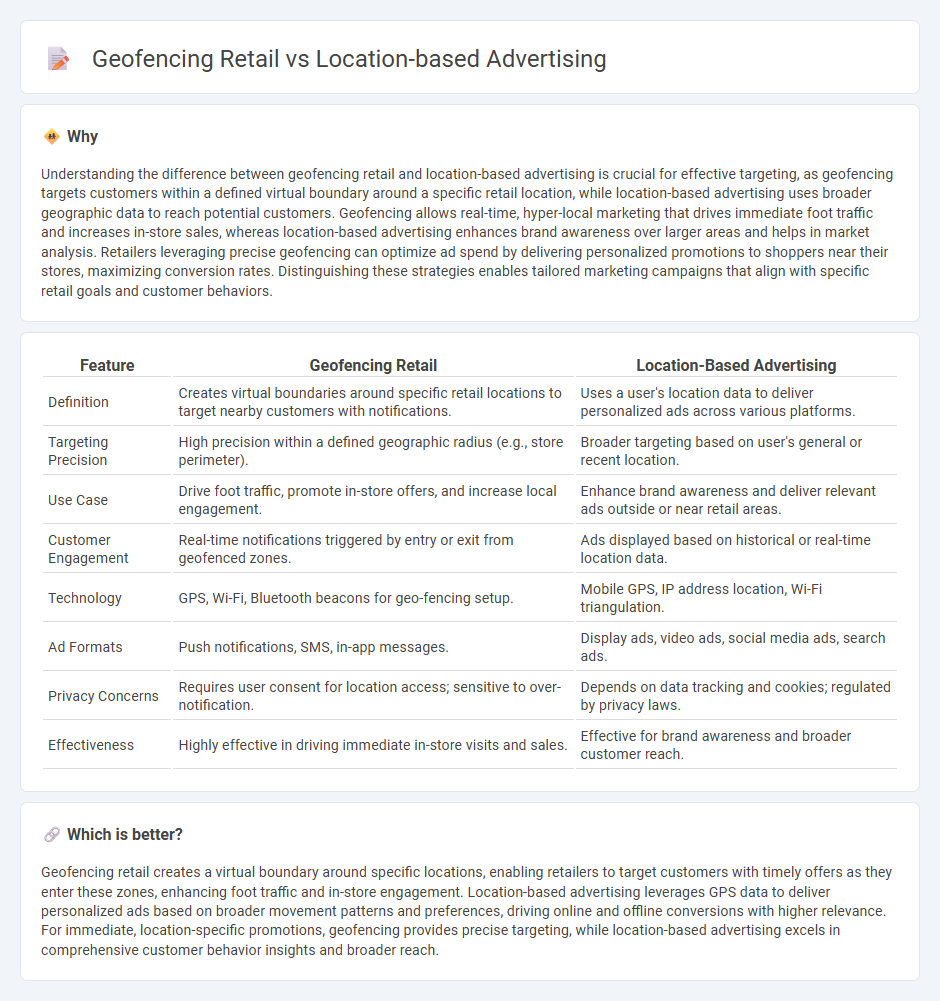
Geofencing retail leverages virtual boundaries around physical stores to trigger targeted marketing messages when customers enter specific geographic zones. Location-based advertising uses real-time GPS data to deliver personalized promotions based on a consumer's current position, enhancing relevance and engagement. Explore how these innovative strategies transform customer experiences and boost retail sales.
Why it is important
Understanding the difference between geofencing retail and location-based advertising is crucial for effective targeting, as geofencing targets customers within a defined virtual boundary around a specific retail location, while location-based advertising uses broader geographic data to reach potential customers. Geofencing allows real-time, hyper-local marketing that drives immediate foot traffic and increases in-store sales, whereas location-based advertising enhances brand awareness over larger areas and helps in market analysis. Retailers leveraging precise geofencing can optimize ad spend by delivering personalized promotions to shoppers near their stores, maximizing conversion rates. Distinguishing these strategies enables tailored marketing campaigns that align with specific retail goals and customer behaviors.
Comparison Table
| Feature | Geofencing Retail | Location-Based Advertising |
|---|---|---|
| Definition | Creates virtual boundaries around specific retail locations to target nearby customers with notifications. | Uses a user's location data to deliver personalized ads across various platforms. |
| Targeting Precision | High precision within a defined geographic radius (e.g., store perimeter). | Broader targeting based on user's general or recent location. |
| Use Case | Drive foot traffic, promote in-store offers, and increase local engagement. | Enhance brand awareness and deliver relevant ads outside or near retail areas. |
| Customer Engagement | Real-time notifications triggered by entry or exit from geofenced zones. | Ads displayed based on historical or real-time location data. |
| Technology | GPS, Wi-Fi, Bluetooth beacons for geo-fencing setup. | Mobile GPS, IP address location, Wi-Fi triangulation. |
| Ad Formats | Push notifications, SMS, in-app messages. | Display ads, video ads, social media ads, search ads. |
| Privacy Concerns | Requires user consent for location access; sensitive to over-notification. | Depends on data tracking and cookies; regulated by privacy laws. |
| Effectiveness | Highly effective in driving immediate in-store visits and sales. | Effective for brand awareness and broader customer reach. |
Which is better?
Geofencing retail creates a virtual boundary around specific locations, enabling retailers to target customers with timely offers as they enter these zones, enhancing foot traffic and in-store engagement. Location-based advertising leverages GPS data to deliver personalized ads based on broader movement patterns and preferences, driving online and offline conversions with higher relevance. For immediate, location-specific promotions, geofencing provides precise targeting, while location-based advertising excels in comprehensive customer behavior insights and broader reach.
Connection
Geofencing retail leverages location-based advertising by triggering targeted promotions when potential customers enter a predefined geographic boundary, enhancing personalized shopping experiences. Retailers use geofencing to collect real-time data on consumer behavior and foot traffic patterns, optimizing marketing strategies and inventory management. Combining these technologies boosts customer engagement and drives higher conversion rates through timely, location-specific offers.
Key Terms
Proximity Targeting
Location-based advertising leverages GPS data and mobile device signals to deliver targeted ads to users within a broad geographic area, optimizing reach and relevance. Geofencing retail creates a virtual perimeter around specific retail locations, triggering hyper-localized promotions and notifications when customers enter or exit these zones, enhancing in-store engagement. Explore how proximity targeting strategies differentiate these approaches to maximize customer conversion and brand loyalty.
Real-time Notifications
Location-based advertising targets potential customers based on their general geographic area using data such as IP addresses and GPS coordinates, offering broad-reaching marketing campaigns. Geofencing retail employs precise virtual boundaries around specific store locations, triggering real-time notifications and personalized offers the moment customers enter these zones. Explore the advantages and implementations of real-time notifications in both strategies to enhance customer engagement and drive sales.
Physical Store Footprint
Location-based advertising leverages GPS data to target consumers near a broader geographic area, enhancing brand visibility across multiple channels, while geofencing retail creates a virtual perimeter around physical store footprints to deliver precise, real-time promotions to nearby shoppers. Physical store footprint optimization through geofencing increases in-store traffic and conversion rates by engaging customers at the exact moment they are in or near the retail environment. Discover more about how these strategies can transform your retail marketing and drive foot traffic effectively.
Source and External Links
What is Location-Based Marketing? The Full Guide - Location-based marketing enables targeting consumers with personalized messages based on their physical location, improving customer experience and conversion by leveraging data from connected devices like phones and watches for tactics such as geotargeting and push notifications.
Location-Based Marketing: Complete Guide for 2025 - This marketing strategy tailors messages using geographic info to boost conversion rates and customer insights, with popular methods like geotargeted mobile ads and geofencing that trigger in-app promotions when users enter specific areas.
Location-based advertising - Location-based advertising integrates mobile ads with location services to deliver content either pushed to users (opt-in or opt-out) or pulled by users searching for location-specific info, often involving messaging, display, search, or product placement ads.
 dowidth.com
dowidth.com